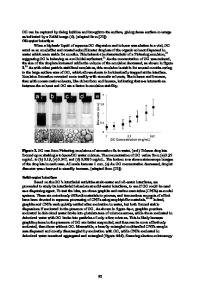Graphene oxide film as a template for the creation of three-dimensional lamellar metal oxides and reduced graphene oxide
- PDF / 475,802 Bytes
- 5 Pages / 612 x 792 pts (letter) Page_size
- 7 Downloads / 383 Views
esearch Letters
Graphene oxide film as a template for the creation of three-dimensional lamellar metal oxides and reduced graphene oxide/metal oxide hybrids Xiguang Gao, Mahyar Mazloumi, Louis Cheung, and Xiaowu (Shirley) Tang, Department of Chemistry & Waterloo Institute for Nanotechnology, University of Waterloo, 200 University Avenue West, Waterloo, ON N2L 3G1, Canada Address all correspondence to X. Tang at [email protected] (Received 12 August 2014; accepted 27 October 2014)
Abstract Here we report a general method for the synthesis of layered inorganic nanocrystalline materials using graphene oxide (GO) film as the template. Free-standing three-dimensional (3D) lamellar ZnO, α-Fe2O3, and reduced GO/ZnO hybrid structures were synthesized as examples. Such layered structures could also be exfoliated to obtain 2D assembled nanocrystal microsheets. The abundant nucleation sites on the GO surface and the compact stacking of GO platelets made it possible to tightly control metal oxide crystal size (∼15 nm), alter preferential crystal growth direction, and assemble the nanocrystals into sheets, as confirmed by multiple characterization techniques.
Inorganic materials, mainly silica and metal oxides (MOs), with long-range ordered nanostructures have found a wide range of significant applications.[1–5] Two types of template methods are typically used to achieve the long-range ordering.[6–8] Soft template method uses surfactants or polymers which form micelles with certain nanoscale features in the liquid phase to guide the growth of inorganics, whereas hard template method (or nanocasting) uses hard templates such as anodic aluminum oxide (AAO) membranes, mesoporous silica, zeolites, and carbon, which possess well-defined voids, channels or other mesostructures, to synthesize inorganics with negative replicas of the template structures. Typical procedures involved in the hard template method include: (I) impregnation of metal- or silicon-containing precursors into a template; (II) nucleation and growth of inorganic nanostructures; (III) removal of the template by chemical treatment (e.g., treatment with HF or NaOH to remove silica template) or calcination (typically for removal of polymer and carbon templates). The hard template method has the advantage of creating a variety of longrange ordered inorganics with high crystallinity. For example, α-Fe2O3 with an ordered mesoporous structure and crystalline walls was synthesized using mesoporous silica KIT-6 as a hard template.[9] Chiral nematic ordering was successfully transferred to free-standing nanocrystalline TiO2 films using chiral nematic mesoporous silica films as hard templates.[4] Here, we demonstrate that free-standing graphene oxide (GO) film (or paper) can be used as a novel new type of templates for the syntheses of MO and reduced GO (rGO)/MO hybrid materials with ordered nanocrystalline MO particles. GO film possesses well-defined layers with a nano-ranged d-spacing (0.6–1.2 nm),[10,11] which templates the assembly
of MO nanocrystals into two-dimensional (2D) sh
Data Loading...











